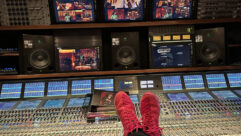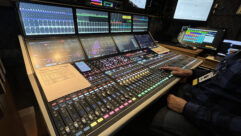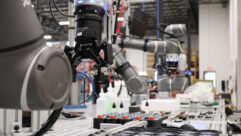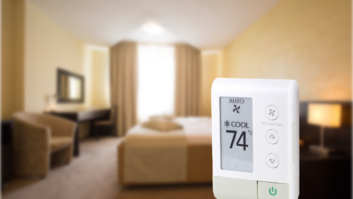

Crank High Voltage, the new film from co-directors Mark Neveldine and Brian Taylor, picks up where their acclaimed 2006 Crank left off to deliver even greater thrills for action-movie fans. This time around these innovative directors further “cranked-up”? the pace and unique visual style of their film by shooting it with professional and consumer HD camcorders from Canon U.S.A., Inc., a leader in digital imaging. Neveldine, Taylor, and director of photography Brandon Trost cited several reasons for this choice, the primary ones being the lightweight portability and excellent HD image quality of both Canon’s XH A1 3-CCD camcorder and Canon’s consumer-level VIXIA HF10 Dual Flash Memory camcorder.
“We keep the camera moving all the time, and on this film we moved it in ways it has never been moved before,”? Taylor explained. “We always felt that we needed cameras that were even more versatile and smaller than what we used on Crank,”? Neveldine added. “Because we shoot on roller blades, hang out of helicopters, and do lots of other crazy things, we needed cameras that are incredibly powerful but also really small and fun.”?
Digital cinematography is common today in Hollywood, thanks to the 24-frame capabilities of modern HD technology. That said, before the Crank High Voltage filmmakers could commit to shooting their movie with any brand of small prosumer and consumer HD camcorders they first had to make sure that those cameras could deliver footage of sufficient image quality for transfer to 35mm film, which is necessary for theatrical exhibition.
“Knowing the size and mobility of the cameras we wanted, it was really just a question of which one gave us the images that we liked,”? Taylor noted. “We did film-out tests with several different brands of cameras and discovered that Canon’s new generation of small, lightweight camcorders provide the image quality we needed. Their images look just incredible when transferred to film. Ninety-eight percent of the movie was shot with Canon XH A1 and HF10 HD camcorders. They enabled us to move fast and save time. We feel like camera technology has finally caught up with what we do.”?
“Run-and-Gun”? Coverage
“As DP, I had as many as 25 cameras to govern on this film,”? Trost explained “We had three camera operators shooting, as well as Mark and Brian and myself. Outside of that we also had an AC for each camera. We never had a shot list. Instead it was ‘anything goes.’ Mark and Brian and I collaborated on seeing how many cool shots we could come up with in the heat of the moment, and that’s how we made the movie.”?
“The whole film is shot like a skate video,”? Trost said. “Mark was on rollerblades for half the movie as one of the camera operators. He was towed by cars at 50 miles per hour while holding a Canon HD camcorder to get dynamic shots he could never get otherwise. We shot primarily with the Canon XH A1 and also used the HF10 camcorder for smaller shots.”?
“Throughout the entire shoot we would plant the little HF10 cameras wherever we could. We put those camcorders on remote-control cars and crazy stuff like that. There were even a couple scenes where the ‘hero shot’ was actually done with an HF10. For the most part the HF10 was a great secondary camera to use in little nooks and crannies to get angles we’d never have captured otherwise.”?
“We also took a half-circle piece of Speed-Rail and mounted eight little HF10’s on it, which was light enough for Mark to do hand-held shots while skating,”? Trost added. “He used it for effects shots and to follow [the movie’s star] Jason Statham while he was running. The idea was to be able to edit the eight cameras’ shots together so the viewer’s perspective on the action scoots from one side of the frame to the other.”?
“Some of the images in this movie are so amazing, we do not think film people are going to understand how we got them until they see what this rig that we built actually looks like,”? Taylor said.
“The footage from the XH A1’s and the HF10’s intercut really well,”? Trost noted. “You would be hard-pressed to tell which shots in the film came from which camcorder. Using so many cameras made things spontaneous and added an urgency to the action that I do not think we could have captured otherwise We were shooting so fast, we were pulling off around 100 shots a day. We were able to take those little cameras and apply them toward telling the film’s story in any way that we could imagine.”?
“We did a boat scene that we shot out of a helicopter, where someone was being dragged behind a boat,”? Neveldine said. “The cameras held up and were great, and we would probably do it again.”?
“With cameras that small and mobile, there is really no limit,”? Taylor added. “You do not have to do traditional mounting. You just grab the camera and move. We had certain scenes where we were shooting a crash or an explosion and we literally put 16 cameras on it. We just set them up anywhere we thought something interesting might happen. I think we only broke two of them.”?
“Sometimes our actors did not even know how many cameras were trained on them,”? Trost confided. “We have one scene where Jason is fighting off a dozen other guys. Right as we are calling ‘Roll camera’ and about to call ‘Action,’ Jason yells out ‘Where is all the cameras?’ And I yelled back to him, ‘There are 12 of them out there, man, just go.’ ”?
The Right Look
The Crank High Voltage production team shot their film using the 24F frame rate on their XH A1 HD camcorders and the 24p Cinema Mode on their VIXIA HF10 HD camcorders. The XH A1 features a Genuine Canon 20x HD video zoom lens and three 1/3-inch native 16:9 Megapixel CCDs (1440 x 1080) for outstanding picture quality, highly accurate color reproduction, and wide dynamic range with virtually no color noise. The camcorder also features Total Image Control for customizing image and color settings. The VIXIA HF10 dual Flash Memory consumer HD camcorder includes a Genuine Canon 12x HD video zoom lens and a 3.3 Megapixel Full HD CMOS sensor (1920 x 1080) for superb resolution and accurate color. The HF10 also features a Program AE mode, which automatically adjusts its settings depending on different exposure situations. Both of these Canon HD camcorders feature Canon’s proprietary DIGIC DV II HD advanced image processor to ensure optimum detail and clarity.
“I set-up all the XH A1 camcorders so they all matched, and I set up the HF10’s to match as well,”? Trost recalled. “My AC’s that were looking out for the HF10’s had their work cut out for them, because we used 15 of these cameras.
“I have always had a lot of success with Canon camcorders, in terms of their adjustments and internal menus,”? Trost elaborated. “I have always relied on their Cinema settings, which are always close to providing the look we want in the end. On Crank High Voltage I ‘zeroed everything out’ and shot with those settings, which gave us exactly what we wanted to be able to color-time from. It has always worked out very well to keep the settings simple and treat the resulting footage as its own ‘film stock.’
“The cameras are good in low light, but we didn’t use them for that at all in this movie,”? he added. “We used bigger-movie-style lighting because we needed all the light we could get. I found the right setting on the lenses, where everything would be in focus within reason. We also cranked-up the detail on these cameras because we wanted to keep that sharp, glossy kind of look that you get with the short shutter. The style is very fitting for the content of the film. It’s almost visually assaulting, but it works well for the movie.”?
The Editor’s Medium
“We recorded 270 hours of footage during Crank 2’s 30-day shoot, which is more than movies usually shoot over the course of several months,”? Taylor reported. “There was no way we’d ever be able to work at that level with any of the other camera systems that we’ve used up to this point. Shooting all that on 35mm or even traditional HD would have been cost-prohibitive, but not with these camcorders. Technically, we had no issues. Of course, with that much footage, just watching and logging through all the dailies becomes a big job.”?
“The result is more footage for the editorial department, which is a post-production challenge,”? Neveldine agreed, “but when it comes to putting the movie together, it’s a blessing and you love it. The more good footage you can get, the better.”?
“This movie is very much the editor’s medium,”? Trost elaborated. “We rolled so many cameras throughout the day that we often ended up with more hours of footage per day then the hours we actually shot. This gives the editor a wide variety of shots to choose from. Even in a short scene, he can make 30 or 40 different edits and each cut will be from a different shot, which really is phenomenal.”?
The Perfect Choice
“I am excited to see this movie on a big theater screen,”? Trost stated. “I do not think anyone will ever have seen a movie that looks quite like this one. I feel like we’ve taken a new medium and stretched it beyond what people view as traditional filmmaking. We weren’t limited to what counts as a classic cinematic tone or style. We used the Canon HD camcorders to heighten the reality and surreal nature of Crank High Voltage, because it’s very much its own world.”?
“The film does not have a so-called ‘video-look,’ it has an amazing look that even film people aren’t going to be able to place,”? Taylor noted. “We don’t think the average movie-goer will have any idea what this movie was shot on, nor will they care, and neither is that important. What is important is the story they are watching, which we shot using Canon HD camcorders.”?
“The way we photographed this movie pushes the envelope,”? Neveldine concludes. “There will be people trying to do what we’ve done on this movie, but they may not end up with the results that we got because of the amount of experimentation that we did with the cameras before we went into it. Then again, the tools are evolving, so there’s no reason why more and more people shouldn’t be shooting this way. It all depends on the project. For this project, the Canon XH A1 and HF10 camcorders were the perfect choice.”?
About Canon U.S.A., Inc.
Canon U.S.A., Inc., is a leading provider of consumer, business-to-business, and industrial digital imaging solutions. Its parent company, Canon Inc. (NYSE:CAJ), a top patent holder of technology, ranked third overall in the U.S. in 2008” , with global revenues of US $45 billion, is listed as number seven in the computer industry on Fortune Magazine’s World’s Most Admired Companies 2008 list, and is on the 2008 BusinessWeek list of “Top 100 Brands.”? At Canon, we care because caring is essential to living together in harmony. Founded upon a corporate philosophy of Kyosei – – “all people, regardless of race, religion or culture, harmoniously living and working together into the future”? – – Canon U.S.A. supports a number of social, youth, educational and other programs, including environmental and recycling initiatives. Additional information about these programs can be found at
. To keep apprised of the latest news from Canon U.S.A., sign up for the Company’s RSS news feed by visiting
.
# # #
” Based on weekly patent counts issued by United States Patent and Trademark Office.










